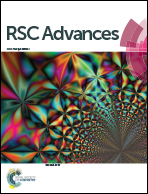Hybrid aminopolymer–silica materials for efficient CO2 adsorption
Abstract
The present work focuses on the development of a new eco-efficient chemical method for the polymerization of aziridine to hyperbranched polyethyleneimine (PEI) into mesoporous silica by using compressed CO2 as a solvent, reaction medium and catalyst. PEI was in situ grafted into MCM-41 and silica gel substrates, with pore diameters of 3.8 and 9.0 nm, respectively. The optimal polymerization conditions were found by varying the reaction pressure (1.0–10 MPa), temperature (25–45 °C) and time (20–400 min). The thermal stability analysis indicated that aminopolymer chains were covalently attached on the amorphous silica surface. The described compressed CO2 route for the synthesis of high amine content hybrid products (6–8 mmolN g−1) is a very fast method, with processing times in the order of few minutes even at very low working pressures (1.0 MPa), being a step forward in the design of efficient hybrid aminopolymer nanocomposites for CO2 capture. The adsorptive behavior of the prepared hybrid materials was experimentally established by recording the N2 (−196 °C) and CO2 (25, 50 and 75 °C) adsorption isotherms. Results were compared to molecular simulation studies performed using Grand Canonical Monte Carlo for either N2 or CO2 adsorbed on amino modified MCM-41, thus helping to elucidate the predominant PEI configuration present in the functionalized materials.



 Please wait while we load your content...
Please wait while we load your content...